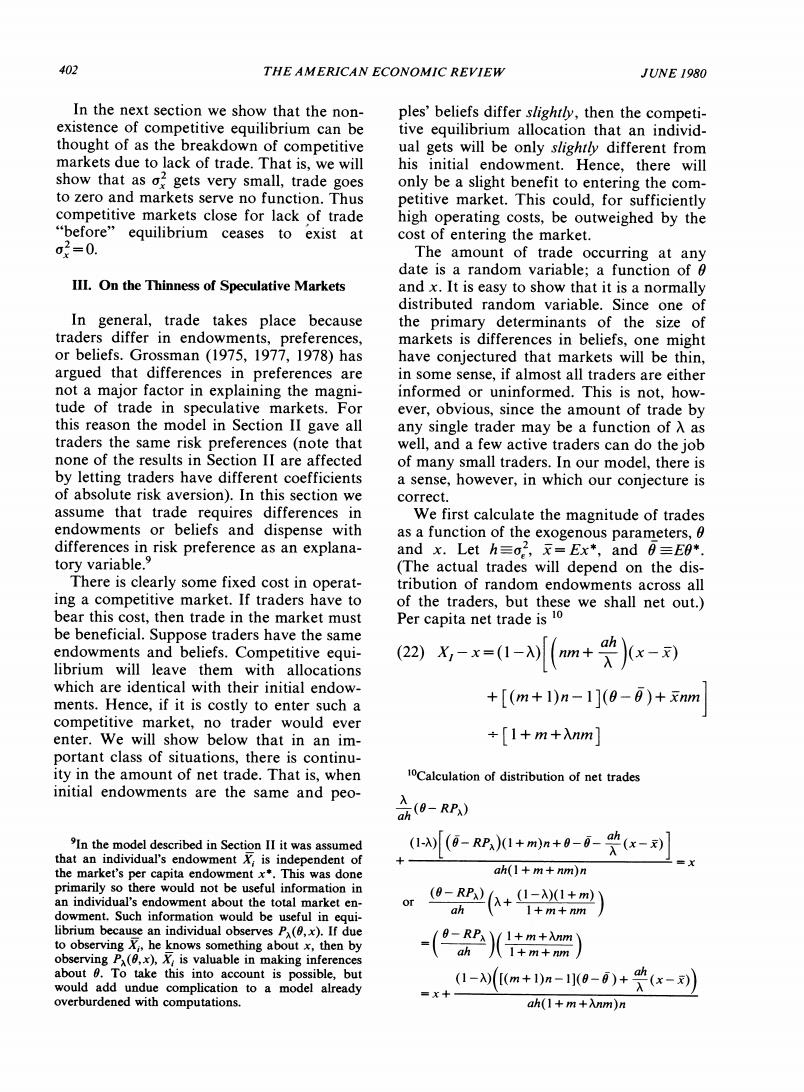正在加载图片...

402 THE AMERICAN ECONOMIC REVIEW JUNE 1980 In the next section we show that the non- ples'beliefs differ slightly,then the competi- existence of competitive equilibrium can be tive equilibrium allocation that an individ- thought of as the breakdown of competitive ual gets will be only slightly different from markets due to lack of trade.That is,we will his initial endowment.Hence,there will show that as o gets very small,trade goes only be a slight benefit to entering the com- to zero and markets serve no function.Thus petitive market.This could,for sufficiently competitive markets close for lack of trade high operating costs,be outweighed by the “before”equilibrium ceases to exist at cost of entering the market. 02=0. The amount of trade occurring at any date is a random variable;a function of 0 III.On the Thinness of Speculative Markets and x.It is easy to show that it is a normally distributed random variable.Since one of In general,trade takes place because the primary determinants of the size of traders differ in endowments,preferences, markets is differences in beliefs,one might or beliefs.Grossman (1975,1977,1978)has have conjectured that markets will be thin, argued that differences in preferences are in some sense,if almost all traders are either not a major factor in explaining the magni- informed or uninformed.This is not,how- tude of trade in speculative markets.For ever,obvious,since the amount of trade by this reason the model in Section II gave all any single trader may be a function of A as traders the same risk preferences (note that well,and a few active traders can do the job none of the results in Section II are affected of many small traders.In our model,there is by letting traders have different coefficients a sense,however,in which our conjecture is of absolute risk aversion).In this section we correct. assume that trade requires differences in We first calculate the magnitude of trades endowments or beliefs and dispense with as a function of the exogenous parameters,0 differences in risk preference as an explana- and x.Let h=o2,=Ex*,and 0=E0* tory variable. (The actual trades will depend on the dis- There is clearly some fixed cost in operat- tribution of random endowments across all ing a competitive market.If traders have to of the traders,but these we shall net out.) bear this cost,then trade in the market must Per capita net trade is 10 be beneficial.Suppose traders have the same endowments and beliefs.Competitive equi- (22) librium will leave them with allocations 名-x=-(m+)x- which are identical with their initial endow- ments.Hence,if it is costly to enter such a +[(m+1)n-1](0-0)+xm competitive market,no trader would ever enter.We will show below that in an im- +[1+m+m] portant class of situations,there is continu- ity in the amount of net trade.That is,when 10Calculation of distribution of net trades initial endowments are the same and peo- 入 (0-RP) 9In the model described in Section II it was assumed (-[(-RR1+m)n+0--(x-x that an individual's endowment X:is independent of the market's per capita endowment x*.This was done ah(1+m+nm)n primarily so there would not be useful information in an individual's endowment about the total market en- 9-RB+-+m dowment.Such information would be useful in equi- ah 1+m+m librium because an individual observes P(,x).If due to observing Xi,he knows something about x,then by observing P(,x),X.is valuable in making inferences about 0.To take this into account is possible,but would add undue complication to a model already (-m+)n-0-)+(x-) overburdened with computations. ah(1+m+Anm)n